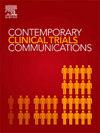评估支持有亲密伴侣暴力经历的移民妇女的数字干预方法:来自It's weWomen加上顺序多任务随机试验(SMART)的发现
IF 1.4
Q4 MEDICINE, RESEARCH & EXPERIMENTAL
引用次数: 0
摘要
最终伴侣暴力(IPV)对移民妇女的影响尤为严重,她们往往在获得面对面服务方面面临障碍。数字干预通过提供量身定制的远程支持,提供了一种有希望的替代方案。在这项SMART试验中,1265名美国外国出生的移民妇女被随机分为个性化在线(n = 660)和标准在线安全信息(n = 605)干预组。在3个月时,低应答者(n = 366)被重新随机分配到仅接受短信(n = 183)或短信+电话支持(n = 183)。在6个月和12个月时评估结果。结果随着时间的推移,所有组的身体和性IPV都有所下降,第一阶段的情况没有显著差异。与应答者相比,短信+电话组的低应答者在3至12个月内表现出更大的身体和性IPV (d = - 0.25, p < 0.01),抑郁(d = - 0.22, p < 0.01)和赋权(d = 0.22, p < 0.01)的减少。这些组间效应得到了组内显著改善的支持,短信+电话组在12个月内缩小或消除了与应答者在大多数结果上的差距。在最初被分配到个性化在线干预的低应答者中,那些重新随机分配到文本+电话支持组的人比那些只接受文本支持组的人表现得更好——IPV (d = - 0.32, p < 0.05)、抑郁(d = - 0.33, p < 0.05)和赋权(d = 0.27, p < 0.05)的减少显著增加。短信组也有所改善,尤其是在抑郁症和创伤后应激障碍方面,结果接近应答组12个月。在各种情况下,低反应者的安全行为也有显著改善(d = 0.24-0.25; p < 0.05)。结论:这些发现突出了阶梯式护理和适应性方法在解决持久的ipvv相关需求方面的价值。将个性化的电话支持整合到数字干预措施中,可以提高那些不单单对简短的、最初的支持有反应的幸存者的结果。本文章由计算机程序翻译,如有差异,请以英文原文为准。
Evaluating digital intervention approaches for supporting immigrant women with intimate partner violence experiences: Findings from the It's weWomen plus sequential multiple assignment randomized trial (SMART)
Background
Intimate partner violence (IPV) disproportionately affects immigrant women, who often face barriers to accessing in-person services. Digital interventions offer a promising alternative by providing tailored, remote support.
Methods
In this SMART trial, 1265 foreign-born immigrant women across the U.S. were randomized to a personalized online (n = 660) or standard online safety information (n = 605) intervention. At 3 months, low responders (n = 366) were re-randomized to receive text-only (n = 183) or text + phone support (n = 183). Outcomes were assessed at 6 and 12 months.
Results
All groups showed reduced physical and sexual IPV over time, with no significant differences between first-stage conditions. Low responders in the text + phone group demonstrated significantly greater reductions in physical and sexual IPV (d = −0.25, p < 0.01), depression (d = −0.22, p < 0.01), and increased empowerment (d = 0.22, p < 0.01), from 3 to 12 months, compared to responders. These between-group effects were supported by significant within-group improvements, with the text + phone group narrowing or closing the gap with responders in most outcomes by 12 months. Among low responders initially assigned to the personalized online intervention, those re-randomized to text + phone support outperformed those receiving text-only support—showing significantly greater reductions in IPV (d = −0.32, p < 0.05), depression (d = −0.33, p < 0.05), and greater gains in empowerment (d = 0.27, p < 0.05). The text-only group also improved, particularly in depression and PTSD, with outcomes approaching those of responders by 12 months. Across conditions, low responders also showed substantial improvements in safety behaviors (d = 0.24–0.25; p < 0.05).
Conclusion
These findings highlight the value of stepped-care, adaptive approaches in addressing persistent IPV-related needs. Integrating personalized phone support into digital interventions can enhance outcomes for survivors who do not respond to brief, initial support alone.
求助全文
通过发布文献求助,成功后即可免费获取论文全文。
去求助
来源期刊

Contemporary Clinical Trials Communications
Pharmacology, Toxicology and Pharmaceutics-Pharmacology
CiteScore
2.70
自引率
6.70%
发文量
146
审稿时长
20 weeks
期刊介绍:
Contemporary Clinical Trials Communications is an international peer reviewed open access journal that publishes articles pertaining to all aspects of clinical trials, including, but not limited to, design, conduct, analysis, regulation and ethics. Manuscripts submitted should appeal to a readership drawn from a wide range of disciplines including medicine, life science, pharmaceutical science, biostatistics, epidemiology, computer science, management science, behavioral science, and bioethics. Contemporary Clinical Trials Communications is unique in that it is outside the confines of disease specifications, and it strives to increase the transparency of medical research and reduce publication bias by publishing scientifically valid original research findings irrespective of their perceived importance, significance or impact. Both randomized and non-randomized trials are within the scope of the Journal. Some common topics include trial design rationale and methods, operational methodologies and challenges, and positive and negative trial results. In addition to original research, the Journal also welcomes other types of communications including, but are not limited to, methodology reviews, perspectives and discussions. Through timely dissemination of advances in clinical trials, the goal of Contemporary Clinical Trials Communications is to serve as a platform to enhance the communication and collaboration within the global clinical trials community that ultimately advances this field of research for the benefit of patients.
 求助内容:
求助内容: 应助结果提醒方式:
应助结果提醒方式:


